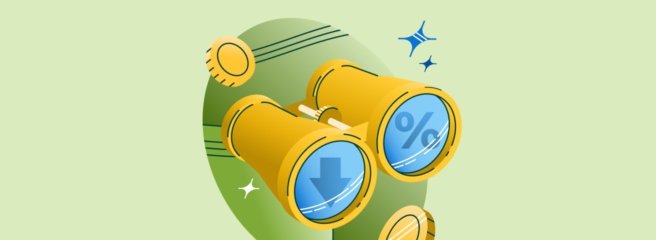
Key takeaways:
- Stagflation is a rare combination of high inflation rates, high unemployment, and low economic output.
- The last major period of stagflation in the U.S. occurred in the 1970s.
- Consolidating expensive debt, increasing your savings, and sticking to a budget can help you prepare for the possibility of stagflation.
More than likely, you’ve seen and heard a lot of news about inflation in 2022. But lately, another risk to the U.S. economy has emerged: stagflation.
Stagflation is a rare economic phenomenon first identified in the 1960s. So far, only one major stagflationary period has occurred in the U.S., during the oil crisis of the 1970s.
Today, economists are divided over whether 2022’s economic conditions could result in a recession or stagflation. Only time—and market behavior—will tell.
In the meantime, it’s essential to learn more about stagflation, its effects, and how to prepare for it. Read on for everything you need to know about stagflation, plus ways you can prepare financially.
What is stagflation?
Stagflation occurs when high inflation combines with economic stagnation. During stagflationary periods, economic growth slows, unemployment rises, and prices increase, resulting in high inflation rates, fewer jobs, and less access to money and credit.
Pro tip: The term “stagflation” was coined in the 1960s by U.K. politician Iain Macleod. Roughly a decade later, the term was first used to describe the U.S. recession of the 1970s.
Effects of stagflation
Stagflation combines two difficult economic conditions: higher prices and fewer jobs. Because of this, it can have several detrimental effects on consumer life:
- Increased costs of goods and services
- Reduced purchasing power
- Reduced or nonexistent salaries
- Higher unemployment rates
What causes stagflation?
Economists have identified two main drivers of stagflation: economic policy missteps and supply-side shocks.
Poor economic policies and supply-side shocks can happen at the same time, worsening the effects of both. However, they may also happen independently.
Let’s take a closer look at both possible causes of stagflation:
Poor economic policies
The U.S.’s central bank, the Federal Reserve (Fed), tracks economic activity in order to make monetary policies.
For instance, during prolonged periods of high inflation, the Fed may increase interest rates in an attempt to reduce consumer and business spending. Less spending can help slow the unchecked economic growth that leads to rising inflation.
However, missteps in economic policies can result in negative outcomes:
- The Fed may increase taxes and raise the minimum wage, leaving business owners to contend with higher labor costs and higher taxes.
- The Fed may not raise interest rates quickly enough, resulting in increased consumer demand, rapidly rising prices, and a labor force demanding higher wages.
If left unchecked, these market conditions could potentially result in a stagflationary period.
Supply-side shock
A supply-side shock is an unexpected event that affects the supply of a product or commodity. A supply shock may increase prices for goods or services. It may also cause supply chain disruptions, reducing access to certain commodities.
A good example of a supply shock is rising oil prices. When oil prices increase, costs rise across virtually every business sector.
Following a supply-side shock, businesses often try to pass on higher costs to consumers or workers:
- Consumers may face higher prices.
- Workers may face layoffs or wage cuts.
The effects of a supply shock can result in higher rates of inflation and unemployment. Lost jobs and lower wages may cause consumers to cut back on spending, which can slow demand and economic growth.
Businesses may also reduce production to offset higher prices and lower demand, creating a stagflationary mix of high inflation, slow economic growth, and fewer job opportunities.
What’s the difference between stagflation, recession, and inflation?
Stagflation, inflation, and recession are often mentioned in the same conversation. Learn more about the differences and similarities of these economic conditions below:
Stagflation vs. recession
Stagflation and recessions share several qualities, including slowing economic growth and rising unemployment rates. However, a recession is a normal part of the economy, unlike stagflation.
Typically, recessions occur following a period of economic growth. During a recession, market activity slows and unemployment increases. But most recessions last less than a year and have lower rates of inflation.
On the other hand, stagflation is an extended period of economic decline. Generally, stagflation results in high amounts of layoffs and rising inflation rates. This results in fewer jobs, lost purchasing power, and higher costs of living.
Stagflation vs. inflation
If inflation rises too quickly or lasts too long, consumer demand may decrease and open the door to stagflation.
Inflation is a defining factor of stagflation. During stagflationary periods, inflation forces prices to increase, causing consumers to cut back on spending and businesses to reduce production. If the spiral continues, the economy may stall and unemployment rates may rise, resulting in stagflation.
Pro tip: On its own, inflation isn’t necessarily a cause for concern. Periods of controlled inflation usually lead to lower unemployment rates and gross domestic product (GDP) growth due to increased consumer demand.
Stagflation vs. recession vs. inflation
Consider the following table for an at-a-glance look at the difference between stagflation, inflation, and recession.
| Stagflation | Recession | Inflation | |
| Prices | Up | Down | Up |
| Consumer Spending | Down | Down | Up |
| Unemployment | Up | Up | Down |
| Economic Growth | Down | Down | Up |
Has stagflation happened before?
The first period of major stagflation occurred in the U.S. in the 1970s. During this time, inflation rates rose above 11% and unemployment climbed close to 9%.
Some economists worry that the high inflation rates and slow economic recovery following the COVID-19 pandemic may result in another period of stagflation.
Will stagflation happen again?
There’s no way to know if stagflation will happen again. As mentioned above, some economists worry the current market conditions could give way to a stagflationary period.
However, others are more optimistic. For example, many economists feared the COVID-19 economic stimulus checks, increased unemployment rates, and supply chain disruptions of 2020 would result in stagflation. Fortunately, it didn’t occur then.
That doesn’t necessarily mean the U.S. economy is in the clear. Macroeconomic conditions and evolving world events could still lead to stagflation.
How does stagflation end?
Ending stagflation can be tricky. The Fed will typically adjust interest rates to fight the effects of stagflation. However, these adjustments can lead to more economic issues.
- If the Fed raises interest rates to combat inflation during a period of stagflation, it can reduce consumer access to cash and credit. This can slow economic growth even further.
- If the Fed lowers interest rates or corporate taxes to spur economic growth, it can cause a sharp increase in inflation.
Instead, Robert A. Mundell—the economist who first identified U.S. stagflation in the 1970s—proposed a combination of tactics to fight stagflation:
- Reduce the tax rate for consumers and businesses to increase buying power and combat high unemployment.
- Moderate credit availability to tighten the money supply and reduce inflation.
It’s critical to implement these policies simultaneously, though. Otherwise, lower tax rates could increase the money supply too rapidly and send inflation soaring. The opposite is also true, as a shrunken money supply could slash credit availability and harm economic growth.
How to counter stagflation
It’s normal to feel worried and stressed about the possibility of stagflation or the current state of the economy. However, focus on actionable steps to counter stagflation and protect yourself financially. Consider the three following strategies:
1. Focus on saving
Saving money may seem difficult during an inflationary or stagflationary period. However, having cash on hand can help you cover higher costs of living without relying on a credit card.
With that in mind, prioritize your savings account and emergency fund. Additionally, look for ways to cut down on expenses, such as canceling subscription services you no longer use.
Finally, make it a point to shop strategically. Check out different grocery stores or use mobile apps to compare prices and find the best deals on essentials.
2. Minimize expensive debt
Saving money is a great idea, but saving while paying off debt isn’t easy. Neither is juggling multiple balances, high interest rates, and minimum payments.
If you’re struggling to make ends meet while paying off debt, you’re not alone. Depending on your circumstances, you may be able to reduce your expensive debt through debt consolidation.
Debt consolidation works by combining multiple balances into a single payment, commonly through a debt consolidation loan or a balance transfer credit card. For example, if you use a debt consolidation loan, you apply for a new loan and use the funds to repay your existing balances. Then, you begin making monthly payments on the single, remaining loan.
Ideally, a debt consolidation loan will come with a lower interest rate or more affordable monthly payments. As a result, you may be able to save money on your debt or get out of debt faster.
3. Stick to a budget
Finally, take some time to create a budget. Many people live without a budget and assume they’re financially healthy. However, you may be surprised to learn where your money goes—and how often you spend it.
Creating a budget can help you feel in control of your finances, which is invaluable during a time of economic uncertainty. A budget doesn’t mean you have to swear off spending entirely, either. Instead, it allows you to direct your resources where they’re more needed and save for the future.
Bottom line: Should I be worried about stagflation?
There’s been a lot to worry about over the last few years: COVID-19, inflation, and unexpected international events. Although the current economic climate could lead to stagflation, it’s not our reality—yet.
Instead of worrying about stagflation, make it a point to strengthen your financial foundation by budgeting smarter. Cut back on expenses where you can and consider consolidating expensive debt. In doing so, you’ll prepare yourself for ongoing uncertainty while building a bright financial future for yourself.






 Won't affect your credit score¹
Won't affect your credit score¹